Businesses outsource their IT efforts to strike the right balance between cost, quality, and predictability of software delivery. Factors such as talent shortages, growing system complexity, and the increasing adoption of AI across platforms and products make the need for reliable outsourcing even more pressing.
But how can you choose the right outsourcing destination and a suitable vendor to delegate your project to? In this article, we analyze five of the most popular destinations for outsourcing software development in Eastern Europe and cover the top criteria that will help you find a reliable partner for your next tech project.
Key takeaways:
- In 2026, IT outsourcing is increasingly driven by talent shortages and AI adoption.
- Eastern Europe offers a strong balance of engineering quality, collaboration efficiency, and cost predictability.
- Businesses with complex, innovation-driven projects favor outsourcers with proven R&D expertise alongside transparent workflows and budgets.
Contents:
Why outsource software development in 2026?
There are several common reasons why large enterprises and IT startups start looking for a trustworthy IT outsourcing company:
- Overcome local talent shortages — The demand for high-level technical expertise in North America, Western Europe, the United Kingdom, and Australia often exceeds the capacity of local talent pools. In fact, 76% of IT employers worldwide admit struggling to find the tech talent they need. Expanding the search beyond local labor markets is one way to address this talent shortage.
- Speed up the time to market — When deadlines are pressing, strengthening the development team with extra talents can be a suitable solution to ensure faster delivery of complex projects.
- Find niche expertise — When faced with non-trivial engineering tasks, businesses may need to engage technical specialists with unique expertise. This is especially true for complex projects such as AI-driven cybersecurity platforms, blockchain-based applications, or custom kernel drivers.
- Optimize budgets — Development and quality assurance costs are closely tied to factors such as taxes and living expenses. To cut costs, businesses often consider outsourcing their software development projects to countries with a better business climate, as it usually results in more reasonable IT service rates.
But in 2026, there’s one more reason to consider outsourcing your software engineering efforts elsewhere — the increasing adoption of artificial intelligence (AI).
As AI initiatives move from experimentation to production, businesses increasingly face challenges related to scalability, reliability, security, and governance of their AI-powered systems. Hiring and training an in-house AI expert may cost your business as much as $200,000 to $300,000 annually, depending on their seniority level. And in-house experts typically have limited exposure to non-trivial tasks and challenges, which may impact their ability to find unusual and efficient solutions in a timely manner.
Working on a diverse range of projects, outsourcing teams typically have unique, firsthand experience and a deeper understanding of non-generic AI use cases and practices than most in-house development teams. They can help you design an efficient AI adoption strategy and mitigate potential risks long before they emerge.
As a result, companies interested in AI adoption choose to outsource:
- AI development — to integrate AI features into existing products, build AI-powered components, and adapt legacy systems to support AI-driven workflows
- Machine learning operations (MLOps) — to ensure efficient deployment, monitoring, maintenance, and optimization of AI models in production environments while managing costs and performance
- AI security and governance — to efficiently address concerns related to data privacy, compliance, model misuse, and emerging AI-specific threats
How can you select a reliable outsourcing partner to delegate these or other engineering tasks to?
One way to start is by choosing your outsourcing destination. For many businesses, Eastern Europe has become the go-to region for IT outsourcing. Let’s see why.
Want to accelerate your product launch?
Apriorit ensures timely delivery for your projects, offering end-to-end custom software and application development services. Let us build you a secure, scalable, and competitive solution.
Why outsource to Eastern Europe?
This region offers a strong price-to-quality ratio. But is that all?
Working with companies from Eastern Europe gives your business all the benefits of outsourcing software development while making certain risks easier to manage.
Compared to Western Europe and North America, Eastern Europe typically offers more competitive rates.
Many countries in Eastern Europe have robust technical education systems and a long-standing engineering tradition. This makes the region a true hotspot for skilled professionals with unique expertise in rapidly developing fields such as artificial intelligence, data science, and IoT solutions. Eastern Europe is an increasingly attractive destination for businesses looking to drive innovation and struggling with talent shortages.
In contrast to other popular IT outsourcing destinations, such as Asia or Latin America, it’s easier for Western companies to establish efficient in-project communication when working with outsourcers from Eastern Europe due to:
- high levels of English proficiency
- similar business values and work culture
- clear expectations around documentation, quality, and accountability
These factors simplify communication and reduce the risk of misalignment between business goals and technical execution.
And for businesses based in Western Europe, outsourcing teams in this region also offer the benefit of high time zone compatibility, making real-time collaboration easy and efficient.
Let’s look closer at specific Eastern European countries where you can find a reliable software outsourcing provider for your next project.
Top 5 outsourcing destinations in Eastern Europe
So, how can you choose a specific country for software development outsourcing in Eastern Europe?
Several factors will help you decide on the right vendor for IT staff augmentation and outsourcing:
- Available talent pool
- Niche expertise in specific domains and technologies
- Level of English proficiency
- Cultural compatibility
- Service costs
If we look at the top software development companies in Eastern Europe listed on Clutch.co, many of them are based in one of the following countries:
- Ukraine
- Poland
- Romania
- Bulgaria
- Czechia
We’ll analyze what each of these countries has to offer and what specifics you need to be aware of.
Ukraine
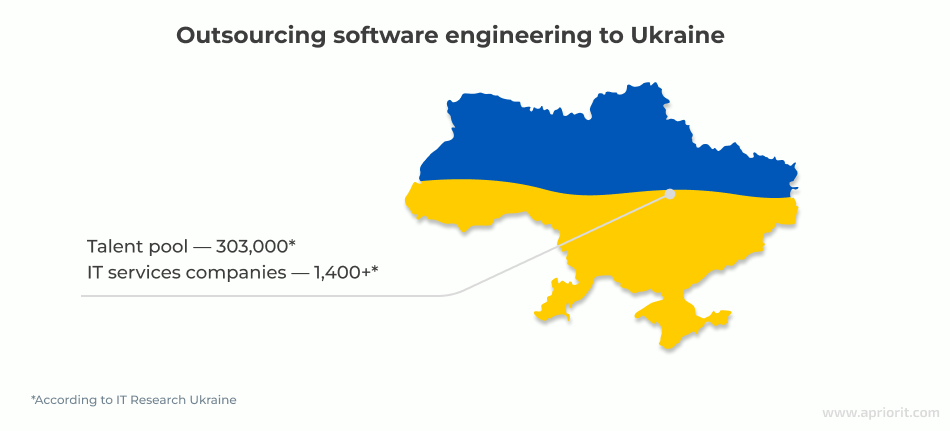
For many years, Ukraine has been one of the best countries for software development outsourcing, not only in Eastern Europe but globally.
According to Clutch.co, many IT services companies in Ukraine list hourly rates in the $25–$49 and $50–$99 ranges. However, these rates are mostly applicable to simple tasks and teams with limited experience. Companies specializing in cybersecurity or low-level development, and especially those offering senior-heavy teams, may charge $100–$149 an hour or more depending on project complexity.
There are several reasons why global businesses work with Ukrainian companies when opting for software development and IT outsourcing in Eastern Europe:
- High quality of services — Ukrainian software development companies are known for delivering quality and secure solutions with well-documented and easy-to-maintain code. Not having to pay twice for fixing development errors also helps businesses use their budgets wisely.
- Rich pool of niche talents — According to the latest IT Research Ukraine report, Ukraine contributes over 303,000 tech talents to the global IT market, demonstrating a continued increase in numbers despite the geopolitical situation. Ukrainian R&D companies are often praised for their rare talents in fields like kernel and driver development, reverse engineering, and cybersecurity. Top technologies in Ukraine include JavaScript, C++, C#, Node.js, and Rust.
- High cultural compatibility — Cultural and linguistic barriers between you and your outsourcing vendor can make communication inefficient and lead to misalignment between project requirements and expectations. Most Ukrainian software engineers speak English fluently and share the same values as their Western colleagues.
The full-scale Russian invasion of Ukraine caused a significant shift in the global outsourcing landscape, leading some businesses to reconsider their partnerships with Ukrainian companies. To address client concerns and ensure business continuity, many Ukrainian IT companies have relocated their employees both within the country and abroad, opening new offices in safer parts of Ukraine and in neighboring countries.
In fact, many businesses that paused or ended their outsourcing relationships with Ukrainian companies in the early months of the invasion are now returning to Ukrainian service providers.
Read also
How to Reduce Time to Market and Release Digital Products Faster
Want to outpace your competitors? Explore proven methods to cut development time without compromising your product’s security and performance.

Poland
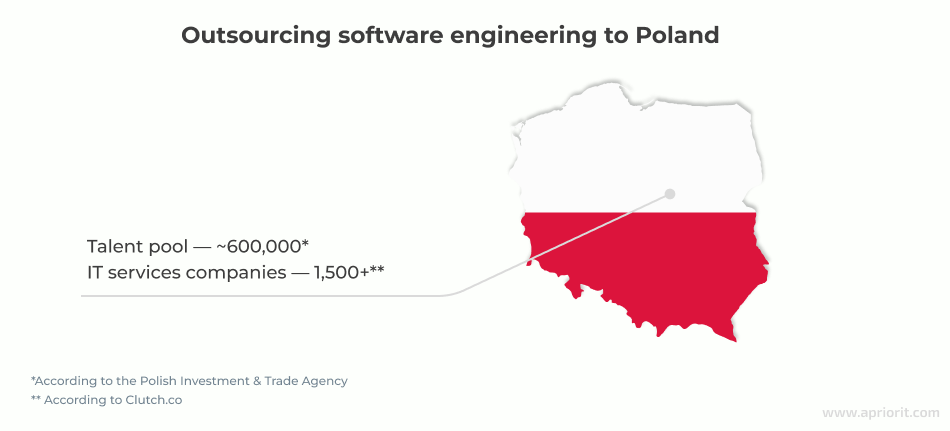
Poland is another commonly evaluated destination for outsourcing software development in Eastern Europe.
- Talent pool — According to the Polish Investment & Trade Agency report, Poland has over 600,000 IT professionals in various fields. With numerous IT experts having relocated to Poland from Ukraine and annual growth in the number of ICT graduates, the Polish market shows promising potential to be strengthened with even more IT specialists in the future. Technologies popular in Poland include Java, JavaScript, PHP, and Python.
- High quality of work — Polish software developers are often praised for the quality of their services, alongside their Ukrainian peers. The report from the Polish Investment & Trade Agency also highlights Poland’s special strengths in the gaming industry.
According to data from Clutch.co, most IT companies in Poland charge $50–$99 per hour, but for companies working on more niche and complex projects, hourly rates can reach as high as $150–$199.
Bulgaria
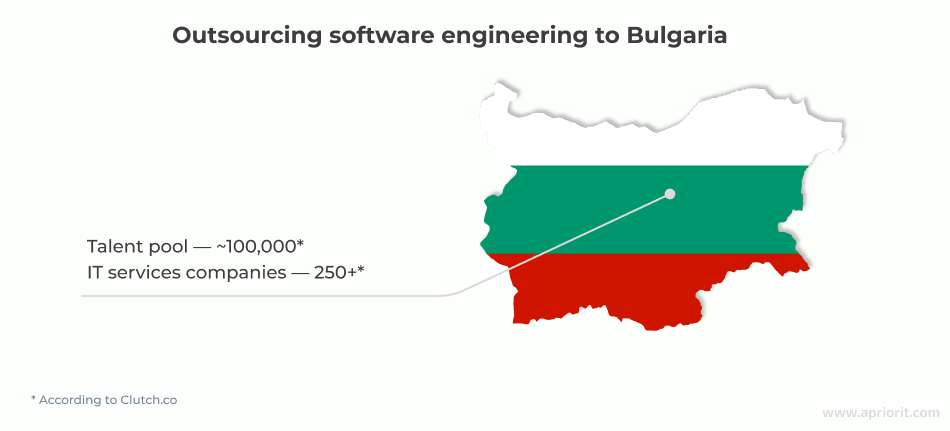
Bulgaria has a rapidly developing IT sector, so businesses also see it as a promising option for outsourcing software development to Eastern Europe. In recent years, the Bulgarian government has adopted a number of legal changes meant to improve the country’s profile as an IT outsourcing destination.
- Talent pool — With over 100,000 ICT specialists, Bulgaria is investing heavily in the development of their IT sector. Common technologies in Bulgaria include C#, Java, and PHP.
- Business climate — Currently, Bulgaria offers one of the most affordable tax rates in Europe — only 10% for both local and foreign IT companies. This creates an attractive business environment in terms of affordable labor and corporate rates compared to North America and Western Europe.
Outsourcing software development in Bulgaria comes with hourly rates ranging between $50 and $99. While this range may appeal to businesses seeking affordability compared to Western Europe or North America, you will need to carefully evaluate cost versus value to ensure you’re getting the expertise you need.
Meanwhile, companies with strong expertise in architecture, cybersecurity, and complex custom software development charge on average $100–$149 an hour.
Romania
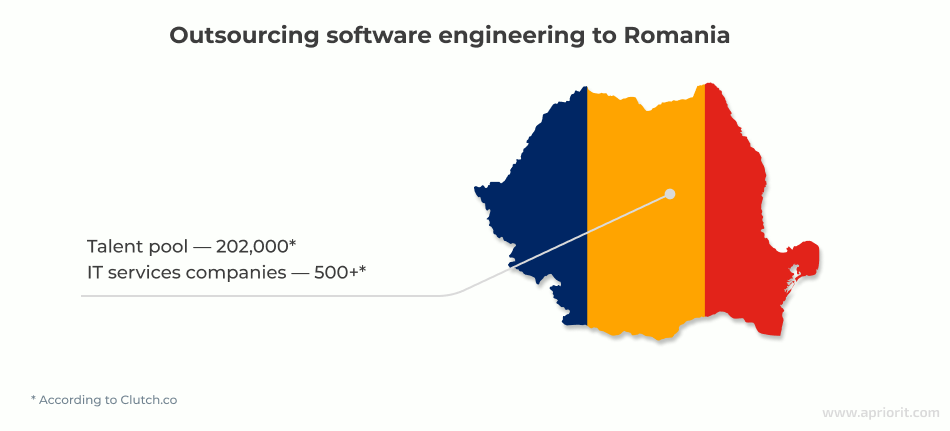
Romania also holds its place on the European IT outsourcing market, drawing the attention of businesses with its:
- Large talent pool — With a strong focus on STEM subjects at local universities, Romania has over 9,000 ICT graduates every year — a powerful addition to the existing pool of over 200,000 professionals. Common technologies Romanian specialists are familiar with include Java, PHP, and Python.
- Language proficiency — Software developers from Romania usually are fluent in English, and the country ranks 11th in the EF English Proficiency Index. In addition, many Romanian IT specialists have a high level of proficiency in other European languages, including German and French.
Like Polish and Bulgarian companies, nearly half of Romanian IT companies charge from $50 to $99 an hour. Those offering unique expertise and niche services charge $100–$149 per hour.
Czechia
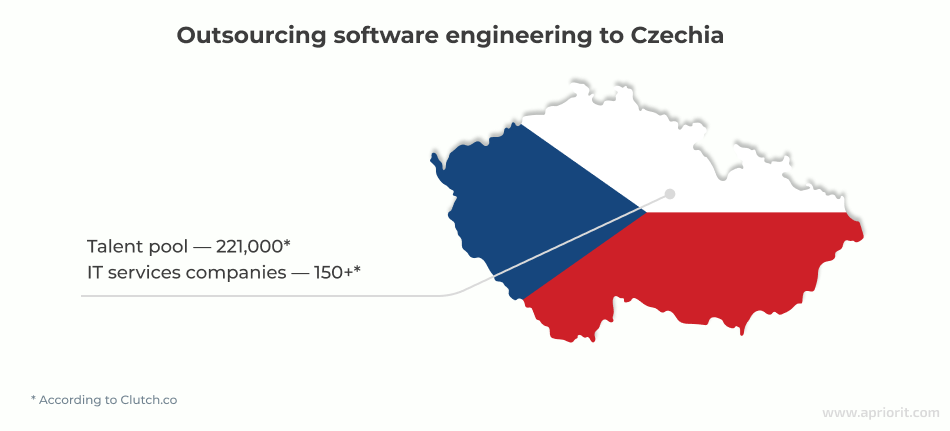
Last but not least, we have Czechia (formerly known as the Czech Republic), a strong IT outsourcing player in the region:
- Talent pool — With over 220,000 IT professionals, Czechia has a solid reputation in the global IT market. In particular, the country adds over 4,400 new ICT graduates to the labor force every year according to data from the Czech Statistical Office.
- Cultural compatibility — With the wide adoption of English, Czechia ranks 23rd among 123 countries evaluated in the EF English Proficiency Index. Establishing efficient communication within a project will be an easy task with a Czech team.
Average hourly rates for software engineering services in Czechia also range from $50 to $99, with technically advanced companies charging $100–$149 per hour.
As you can see, these countries offer comparable hourly rates and advantages to businesses seeking a reliable outsourcing vendor. However, alongside these benefits, there may be hidden challenges that you should account for before making your final decision. Let’s discuss them.
Challenges of outsourcing to Eastern Europe
Eastern Europe is a mature outsourcing destination, but choosing to work with a service provider in this region is only the first step. What will truly position you for success is the ability to identify and manage common outsourcing risks before they turn into budget overruns, delays, or quality issues.
Let’s look at the most common challenges businesses face when outsourcing software development to Eastern European companies:
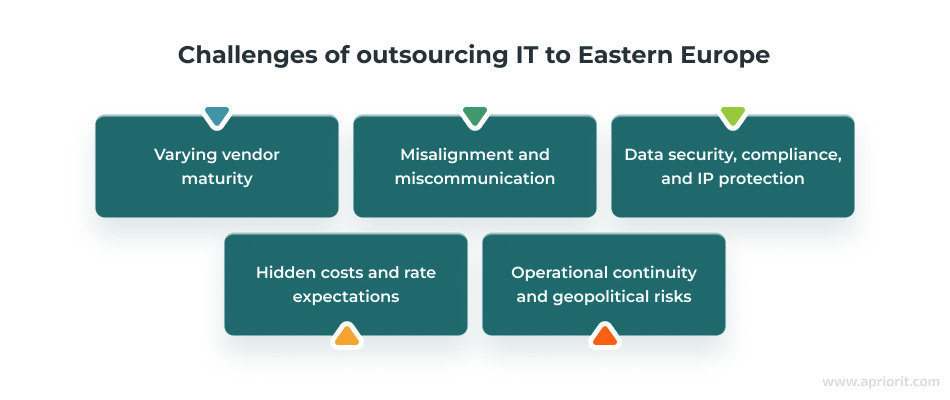
1. Varying vendor maturity
Even within the same country, service providers can differ significantly in their engineering standards, documentation practices, QA depth, security protocols, and delivery predictability. Insufficient vendor maturity is one of the most common reasons behind the underperformance of outsourcing projects.
2. Misalignment and miscommunication
Although IT specialists in Eastern Europe generally have strong English proficiency and there is a high level of cultural compatibility between Eastern European and Western businesses, communication can still pose a risk when projects lack effective governance.
Entering a project with misaligned expectations regarding scope, success criteria, and the definition of done can lead to failure. This is especially true for projects with unclear ownership, inconsistent reporting, or numerous stakeholders without a single point of coordination.
3. Data security, compliance, and IP protection
Outsourcing always increases the number of people and systems that touch your product, your code, and (potentially) sensitive customer data. This expands your third-party risk surface and raises compliance requirements, especially in regulated industries like healthcare and finance.
4. Unrealistic rate expectations and hidden costs
Eastern Europe is known for competitive rates, but prices can be misleading when compared without context. The lowest rates can imply a junior-heavy team, weak QA coverage, limited documentation, or insufficient security practices — all of which can actually increase the total cost of delivery.
When you only look for the lowest price, you risk ending up with a poor-quality, insecure product that will be more expensive to repair and maintain in the long run. This is why, when choosing an outsourcing provider, it’s important to first evaluate the reliability and professionalism of potential candidates.
5. Operational continuity and geopolitical risks
Some Eastern European locations operate under elevated geopolitical uncertainty. This does not automatically make outsourcing unsafe, but it does demand a disciplined approach to continuity from both parties. For example, many Ukrainian companies invest in diversifying their operations and work with distributed teams. While some employees remain in safer regions of Ukraine, others are located abroad.
With these challenges in mind, selecting a trustworthy and reliable IT outsourcing partner should be easier. But to ensure your success, let’s talk about proven ways to assess your potential vendors.
Read also
How to Efficiently Organize and Manage a Distributed Software Development Team
Want to maximize the productivity of global teams? Get expert insights on proven ways to manage distributed teams effectively in order to reduce risks and ensure timely project delivery.

How to choose the right outsourcing company
Finding the right outsourcing partner can be challenging. You should evaluate various factors and choose a partner who can help you achieve your business needs and goals.
Let’s look closer at core criteria for determining which outsourcing company to delegate your project to.
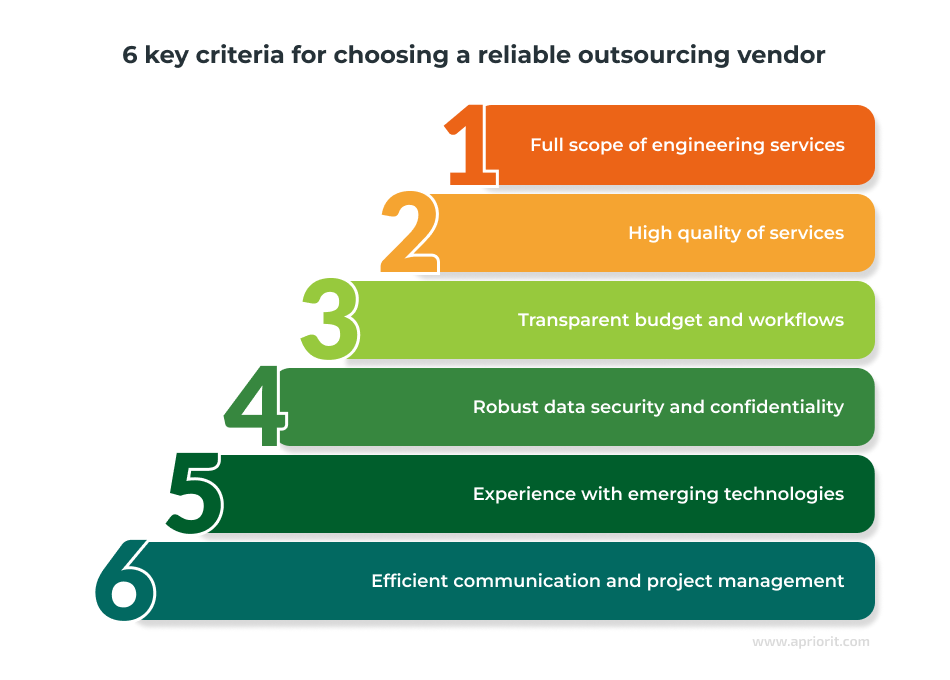
1. Full scope of engineering services
To build a custom solution that is secure, performant, and competitive, look for a software engineering company that can help you with any task, from market research and requirements elicitation to architecture design, security testing, and even DevOps and cloud migration. This way, you can get any expertise your project needs in one place, without wasting resources.
With strong and diverse in-house expertise, outsourcing companies can help you quickly establish a fitting team or close the existing talent gap in your in-house team and thus speed up product delivery. Compared to smaller companies with limited services, large outsourcing companies usually have experience working on complex, non-trivial projects. Also, working with a company that offers flexible team scaling can help adapt resources to changing project requirements, further optimizing costs and timelines.
How Apriorit meets this criterion:
Working with Apriorit, you can form a dedicated team including any experts your project might need, from business analysts and project managers to kernel developers and reverse engineers, and DevOps specialists. Our teams are highly adaptable, allowing us to scale up or down as your project evolves.
Read also
How to Find the Right Outsourcing SaaS Development Company
Learn how to evaluate outsourcing for SaaS development from a business perspective. Get practical guidance on planning, vendor selection, and collaboration models that align with your product vision.

2. High quality of services
Building a competitive product is impossible without competent developers, designers, and quality assurance specialists. You need to evaluate your potential outsourcing partners on two levels:
- Delivery maturity — Your outsourcing partner must demonstrate mature engineering practices aimed at delivering stable, maintainable code with predictable quality. This includes clear internal coding standards, thorough code reviews, strong architecture and documentation habits, and a well-established QA approach that covers everything from functional testing to regression, performance, and security checks. A reliable vendor should also have proven workflows for CI/CD, issue triage, and defect prevention (not just defect detection).
- Business-oriented approach — Your business goals should be the focus of your outsourcer, who needs to understand your objectives and account for them when building your product.
Only when your outsourcer meets your requirements on both levels can you create quality and competitive products.
How Apriorit meets this criterion:
To guarantee the high quality of our code, Apriorit developers rely on internal coding standards and code review practices. We have an internal QA department, enabling you to enhance your dedicated team with strong testing and quality control expertise. Finally, Apriorit has a team of business analysts who can assist you with researching the market and aligning your vision with the reality of your business niche. We also invest in regular training programs and certifications to keep our team up-to-date with the latest industry trends and standards.
However, the best proof of the quality of delivered services is our clients’ feedback. Visit Clutch.co to read what clients say about working with us.
3. Transparent budget and workflows
Long-term partnership is impossible without transparency and mutual trust. As the project owner, you need to have a clear understanding with your outsourcing partner of both project costs and deadlines.
You can ask potential outsourcing partners for a detailed breakdown of their costs, from hourly rates and extra fees to third-party software licenses. Look for partners who can provide various engagement models, such as time and materials or fixed-price agreements, as well as team composition options tailored to your project’s needs. Another important aspect to pay attention to is your partner’s approach to introducing changes to the approved scope of work and budget.
How Apriorit meets this criterion:
With three comfortable pricing models to choose from, Apriorit always provides you with a clear understanding of the costs, deadlines, and expected outcomes of our cooperation. Our transparent and efficient workflows help you maintain a comfortable level of involvement in the project and set realistic expectations for your project’s timeline and budget. Our team is also equipped to handle scope changes effectively, ensuring minimal disruption to your project’s progress.
Read also
How to Choose the Outsourcing Pricing Model for Your Project: Dedicated Team, Time & Materials, Fixed Price
Make sure that your outsourcing strategy delivers maximum value. Explore the strengths and weaknesses of popular pricing models to see how you can mitigate potential risks and choose the model that will benefit your business the most.
4. Robust data security and confidentiality
To mitigate possible cybersecurity risks for your business, pay special attention to the following three levels of data security when choosing an outsourcing provider:
- Security and confidentiality of your business data — Make sure that outsourcing company experts engaged in your project will maintain the security and integrity of your sensitive data. Common ways to do this include signing non-disclosure agreements (NDAs) and limiting outsourcers’ access to critical information. Compliance with relevant data protection regulations (e.g., GDPR, CCPA) is also crucial.
- Security and resilience of the developed product — Opt for companies with strong coding and security standards. Also, evaluate an outsourcer’s experience building software products compliant with relevant IT security requirements.
- Security of your intellectual property — Sign service-level agreements (SLAs) with your outsourcer, clarifying ownership of intellectual property rights and mechanisms for transferring rights to all developed products and code.
How Apriorit meets this criterion:
With over 20 years of experience, Apriorit knows how to ensure ultimate security for both the business relationships we build and the software solutions we develop.
On the business side, we use NDAs and SLAs, along with other measures necessary to build a strong, trust-based partnership. On the technical side, we determine and use the most efficient technologies and approaches, from data encryption to code obfuscation, to deliver a secure and reliable product. Additionally, we not only take into account the requirements of relevant standards like GDPR, HIPAA, and ISO 27001 but also conduct development according to the principles of a secure Software Development Life Cycle (SDLC) to guarantee the compliance and security of your software.
5. Experience with emerging technologies
If your project roadmap relies on innovation, ensure that your outsourcing provider can deliver more than just standard functionality. Look for an outsourcing company with proven expertise in emerging technologies and strong R&D capabilities that enable them to turn experimental ideas into stable, production-ready systems.
In 2026, this often means being able to support AI-native development as well as engineering for complex cyber-physical systems, including robotics and drone solutions. These projects usually come with high requirements for security, performance, safety, reliability, and long-term maintainability, so it’s important to evaluate a vendor’s hands-on experience.
To assess the innovation readiness of a potential vendor, pay attention to:
- Proven domain expertise — Look for evidence that a vendor has delivered AI-native, robotics, or drone-related systems beyond PoCs. In particular, observe how they address constraints such as system performance, reliability, and safety.
- R&D experience — Assess a vendor’s real-life experience working on R&D-heavy projects with changing or partially defined requirements.
- Architectural maturity — Look for a vendor that can help your team design secure and scalable architectures for complex, high-risk systems.
How Apriorit meets this criterion:
Apriorit helps companies build innovation-driven products where quality, security, and performance are critical. We provide AI development and consulting services for businesses that need secure and reliable AI-enabled functionality. Our teams also have first-hand experience delivering custom software solutions for robotics systems, including drone-related solutions and supporting platforms.
Related project
Developing Software for a Drone Battery Charging and Data Management Unit
Discover how the Apriorit team helped our client enhance the efficiency and reliability of their drone fleet by delivering a custom drone operation solution and supporting mobile apps for better battery charging and data processing management.
6. Efficient communication and project management
To have the end product fully match your expectations, it’s vital to establish efficient, business-focused communication within your project. This is where you may need the assistance of an experienced project manager (PM).
Having a seasoned PM on your team is essential, as it can help you:
- Establish a collaborative environment where both your in-house experts and outsourcing professionals can work together as one team
- Save your managerial resources on setting up project processes and workflows
- Align your project vision, business goals, and technical tasks across all stakeholders and development teams
- Detect possible issues with the project’s progress and address them early on
Mature outsourcing companies can provide you with a dedicated project manager (PM) to assist you with orchestrating the work and improving the performance of your development team.
How Apriorit meets this criterion:
Working together towards a shared goal is something Apriorit experts have in common. We have a team of professional project managers — many of whom are Project Management Professional-certified — to help you orchestrate your project. In particular, you will get regular updates on the progress of your project and timely reports to help you make informed business decisions. Our PMs are skilled in Agile, Scrum, and other methodologies, combining them and creating a custom approach to your project benefits and your team.
Read also
Outsourcing Project Management: Concerns, Advantages, and Our Approach
Want to scale your business without scaling stress? See how outsourcing project management can help you maintain control, reduce risks, and achieve consistent success without overloading your in-house team.
Why outsource your R&D project to Apriorit?
Apriorit is a software engineering outsourcing company that helps businesses deliver quality, secure, and competitive solutions. Working with us gives you access to invaluable benefits:
- Niche expertise — Rare talents and exclusive knowledge make us stand out among competitors. You can come to us with the most complex, non-trivial tasks, from building a custom driver for blocking untrusted USB devices to reverse engineering undocumented APIs in order to fix compatibility issues.
- AI-native development expertise — Apriorit helps businesses design and build AI-enabled systems from scratch or integrate AI capabilities into existing infrastructure. From consulting to custom AI development to MLOps, Apriorit can strengthen your project with the exact expertise it needs.
- Fast scaling of your team — Having a rich, well-skilled in-house team, we provide services for tech companies operating in various regions and industries. We can help you quickly scale your dedicated team with the required skills and expertise so that you don’t have to waste time searching for a relevant specialist on the market.
- Deep focus on cybersecurity — Being true masters of cybersecurity, we can assist you with auditing and enhancing an existing product or implementing a secure-by-design approach when building your own custom software — all to help your business stand strong against rising cybersecurity threats and keep your valuable and sensitive data well-secured.
- Business-oriented approach — Aiming for the best outcomes for your business, Apriorit specialists can suggest several project implementation options for you to choose from. Employing the latest technological advances and new tools, we strive to create a pleasant experience for your customers while helping your business save time and money on delivering new products.
- Suitable cooperation models — You can always adjust the terms of cooperation with our company to fit your project’s current stage and goals. For small projects and new partnerships, we often suggest trying out our Fixed Price model, which gives you clear deadlines and a set budget for the project before it even starts. For long-term partnerships, a more suitable option would be the Dedicated Team approach. In this case, you’ll get a full-time team of experts who will work as an integral part of your project.
- Ultimate quality — To help our clients deliver competitive solutions that stand out on the market, Apriorit has a dedicated department of quality assurance professionals who can assist you with auditing, testing, and improving your software. You can trust Apriorit with anything, from implementing the shift-left testing approach when building a custom product to pentesting your ready solution.
- Operational resilience — Having several development offices in Ukraine and Poland, Apriorit has had to take extra measures to ensure the company’s continual operation and the safety of our employees during wartime. These include moving our data centers outside of Ukraine and relocating employees to safer locations.
With a people-oriented culture and strong values at the heart of our company, we attract the best professionals in the field and help young talents grow. This helps us deliver quality and timely results to our clients, even during the most turbulent times.
Conclusion
In the past, businesses outsourced software development to quickly expand in-house teams and access niche domain expertise while staying within strict timelines. These days, the need to address global talent shortages and the growing adoption of AI have only heightened the importance of IT outsourcing.
Eastern Europe remains one of the top destinations for IT outsourcing, offering benefits such as strong cultural fit, high service quality, and competitive rates. However, you should still be aware of possible risks.
When assessing potential vendors, focus on key factors such as service quality and maturity, technology stack alignment, robust governance, and transparency.
Apriorit can set you up with a strong project team that will help you deliver a market-ready, competitive solution tailored to your business needs.
Looking for long-term tech partners?
Apriorit offers dedicated teams that integrate seamlessly with your in-house team and processes, ensuring timely delivery and top-quality results.
FAQ
Why should I choose Eastern Europe over other regions for outsourcing software development?
<p>Eastern Europe is a reliable and practical outsourcing destination for businesses that require predictable delivery, senior engineering expertise, and close collaboration.</p>
<p>Compared to Western Europe and North America, Eastern Europe provides access to equally strong technical expertise at more moderate rates, making it easier to scale teams without dramatically increasing development costs.</p>
<p>At the same time, Eastern European IT service providers offer closer time zone alignment with Western businesses, fewer communication barriers, and stronger cultural compatibility than vendors from Asia. This helps maintain fast and efficient feedback loops.</p>
What types of projects can I outsource to an Eastern European development team?
<p>Eastern European teams can support most software development projects, including:</p>
<ul>
<li>Product development and modernization — web, mobile, desktop, and cloud-native systems</li>
<li>Dedicated QA and quality improvement — test automation, regression testing, performance testing, and security testing</li>
<li>DevOps and cloud engineering — CI/CD, infrastructure automation, monitoring, and reliability work</li>
<li>Cybersecurity-heavy development — secure SDLC implementation, hardening, threat modeling, and compliance-oriented engineering</li>
<li>AI-enabled product engineering — integrating AI functionality into existing products and building AI-backed components</li>
</ul>
What risks should I consider when outsourcing to Eastern Europe, and how can I mitigate them?
<p>The most common outsourcing risks are not specific to Eastern Europe — they can appear in any region:</p>
<ul>
<li>Variations in SDLC maturity, QA coverage, documentation quality, and security practices that affect delivery outcomes</li>
<li>Misalignment on scope and expectations, an unclear “definition of done,” and lack of an established workflow for requirements changes</li>
<li>Additional data security, compliance, and IP risks that come from adding new people and systems to your development process</li>
</ul>
<p>In practice, most of these risks can be mitigated by selecting a vendor with proven delivery maturity and establishing clear governance from the start.</p>
Which engagement models work best for long-term or complex software development in Eastern Europe?
<p>For long-term or complex work, the most practical models are usually:</p>
<ul>
<li>Dedicated team — best for ongoing product development and R&D, where requirements evolve and continuity matters. You get a stable team that can build domain knowledge and work as part of your product organization.</li>
<li>Time and materials (T&M) — best when the scope is flexible or discovery is still in progress. T&M supports iterative delivery and change without constant contract renegotiation.</li>
</ul>
<p>If you’re unsure which collaboration model will best suit your project, reach out to discuss the details with our expert.</p>
How can I reduce the cost of outsourcing software development to Eastern Europe?
<p>Here are some practical ways to optimize your project budget:</p>
<ul>
<li>Begin with a discovery or audit phase to prevent scope creep and identify possible constraints before scaling up.</li>
<li>Prioritize value-critical features and phase out non-essential functionality to reduce early complexity.</li>
<li>Adjust the team composition by matching seniority to risk: use senior specialists for architecture and high-risk components, and use more cost-efficient roles for well-defined implementation tasks.</li>
<li>Agree on quality and security expectations up front to avoid expensive rework later.</li>
<li>Use clear change control methods to prevent scope expansion from quietly inflating budgets and timelines.</li>
How can I assess an Eastern European outsourcing partner?
<p>You can start by evaluating their:</p>
<ul>
<li>Service and technology fit — See if they deliver the services you need and have experience with the technology stack that’s critical for your project.</li>
<li>Engineering process maturity — Ask about their coding practices, code review and QA standards, and security protocols.</li>
<li>Real-life experience — Look at their case studies that are relevant to your domain and project type.</li>
<li>Client feedback — See if they have verified client feedback on trusted platforms like Clutch.co.</li>
<li>A short pilot or discovery phase is often the most reliable way to validate these factors before
scaling your partnership.</li>


